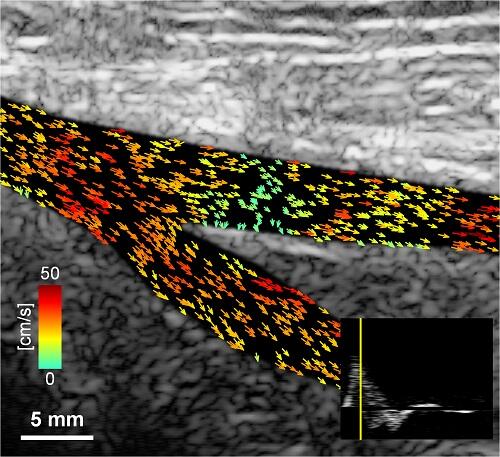
Pushing the potential of ultrasound
Engineering prof Alfred Yu wins Steacie fellowship to pursue high-risk, high-reward research

Engineering prof Alfred Yu wins Steacie fellowship to pursue high-risk, high-reward research
By Brian Caldwell Faculty of EngineeringFor now, Alfred Yu is focused on two distinct lines of research as he works to develop the next generation of ultrasound technology – one involving diagnosis and the other involving therapy.
But when he looks ahead, the University of Waterloo biomedical engineer can see a day when the two converge in a single, powerful tool to guide and deliver medical treatment at the same time.
“Ultrasound is unique because it has both diagnostic and therapeutic potential,” Yu says. “We could use the same modality to both look and poke, to stimulate cells.”

A next-generation ultrasound image created in Alfred Yu's lab shows blood travelling through a femoral artery at different speeds.
To help reach his ambitious goal, Yu got a boost today when he was announced by the Natural Sciences and Engineering Research Council of Canada (NSERC) as one of six nation-wide winners of 2021 E.W.R. Steacie Memorial Fellowships for highly promising researchers.
Winners of the prestigious award receive $250,000 in grants over two years and, via payments of up to $90,000 a year to their universities, are freed from teaching and administrative duties to focus full-time on research.
Yu, a professor of electrical and computer engineering, and a research scientist at the Schlegel-UW Research Institute for Aging, plans to make good use of the time and money to expand his research team, buy equipment and advance both lines of his high-risk, high-reward work.
“It is an important opportunity to make our current research agenda transformative,” he says. “I also look forward to bringing our latest research advances back to the classroom later to teach the most updated knowledge in ultrasonics to our students.”
One aspect of his work involves the development of new ultrasound techniques to obtain valuable quantitative information, in addition to images, on the stiffening of arteries as people age. That diagnostic data, yielded through the use of innovative ultrasound imaging strategies and the analysis of pulse echoes by new algorithms, could help prevent strokes, for instance.
The other research focus in Yu’s lab, the Laboratory on Innovative Technology in Medical Ultrasound (LITMUS), is the interaction between ultrasound waves – sound waves at a frequency range beyond human hearing – and human cells.
There is now only a general understanding that ultrasound can help regenerate damaged tissue by stimulating cells. Yu wants to learn how and why it works, the key to development of much more precise, effective treatments.
“How this actually happens, to be honest, nobody knows,” he says. “We want to study how physics interacts with biology to get a foundational understanding.”
Ultimately, it might be possible, for example, to use new ultrasound imaging technology to pinpoint cancerous tumors for treatment with ultrasound waves.
“We could combine the applications of ultrasound to come up with theranostics, the integration of diagnostics and therapeutics,” Yu says.
The two-year fellowships are named after Edgar William Richard Steacie, a chemist and a researcher who made major contributions to science in Canada during and immediately after World War Two. He also led NSERC from 1952 to 1962.
Main photo: Sylvie Li/Shoot Studio

Read more
Here are the people and events behind some of this year’s most compelling Waterloo stories

Read more
Waterloo Engineering community honours impact and innovation at annual awards dinner

Read more
Meet five exceptional Waterloo graduate students crossing the convocation stage as Class of 2025 valedictorians
The University of Waterloo acknowledges that much of our work takes place on the traditional territory of the Neutral, Anishinaabeg, and Haudenosaunee peoples. Our main campus is situated on the Haldimand Tract, the land granted to the Six Nations that includes six miles on each side of the Grand River. Our active work toward reconciliation takes place across our campuses through research, learning, teaching, and community building, and is co-ordinated within the Office of Indigenous Relations.